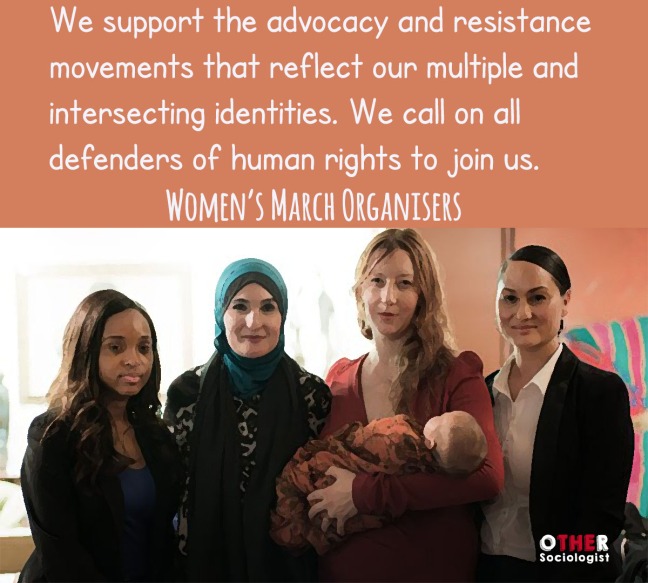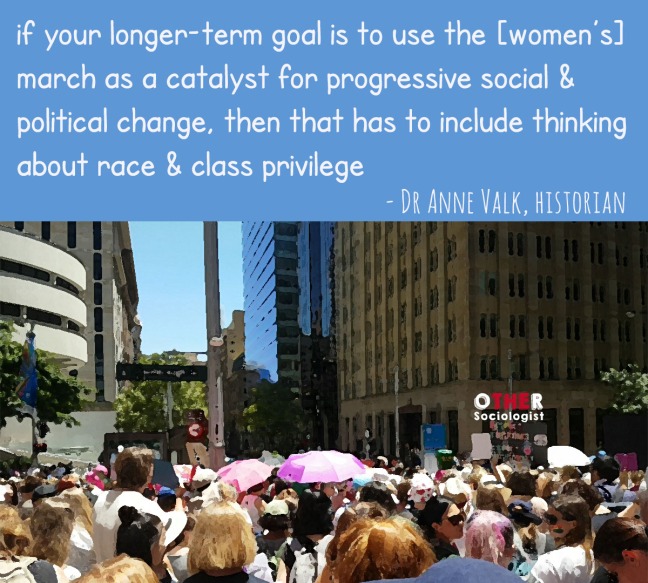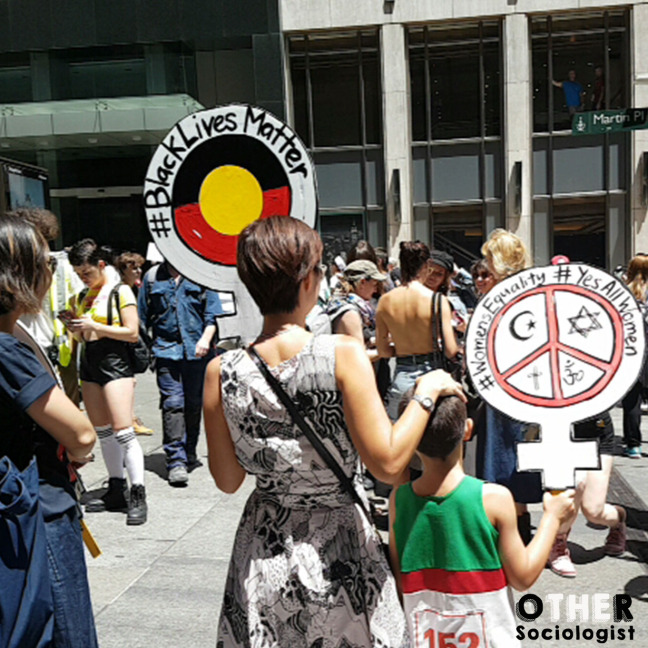This is the first of a two-part reflection on the global Women’s March that occurred on 21 January 2017. It reflects the tensions between the initial goal of the Women’s March in Washington, which aimed to be inclusive of intersectionality, and the White women who wanted to attend the March, but objected to this aim.
Despite many positive outcomes, the issues discussed here that centre on whiteness continued to affect the attendance, experience and discussions of the marches after the event. This post examines the attitudes of White women as discussed in an article by The New York Times, which reflect the broader dissent expressed by white women who continue to oppose intersectional conversations about the Women’s March.
The issues here remain relevant not simply as women around the world reflect on the racism and exclusion they faced at the marches, but also because one of the co-organisers, Linda Sarsour, is currently facing racist backlash only days after the event.
The second part to this discussion is forthcoming and it will be a visual reflection of my attendance at the Sydney March.

Background
The evolution of the Women’s March begins with Tricia Shook, who first suggested a protest against President Donald Trump’s inauguration. Working in Hawaii, her cause was soon hijacked by Pantsuit Nation, a North-American group dominated by White middle-class women who voice an adversarial stance against anti-racism within feminist movements. Bob Bland, founder of Manufacture New York, a White woman, sought to establish a similar protest event in Washington. She reached out to Shook to combine their efforts, and to make it inclusive of women of colour. The co-organisers brought on board are pictured above.
Their collaboration became the Women’s March, in Washington, Sydney and other cities. The original organisers worked tirelessly to consciously focus the march on intersectionality (the connections between gender, race and other social inequalities). This is clear in their mission statement, reproduced in part below.
Discussions leading up to the Women’s March (and since) were riddled with resistance to women of colour’s activism. This dissent is captured in a much-shared New York Times (NYT) article published on the 9 January. The article reproduces many problems counter to anti-racism objectives in its characterisation of conflict amongst women interested in attending the Women’s March. The article mentions the “tone” of women of colour who are challenging White women to think about racial divides, but no critical reflections on tone policing.
Tone policing
Tone policing is a practice where a member of a dominant group chastises the communication style of minority groups who discuss oppression.
Tone policing is a derailment tactic used in discussions of racism, sexism, and other forms of discrimination. Tone policing describes when an individual uses white privilege to deflect the message that another person is conveying, by focusing on an idealised notion of “civility.” If only they could be “nice.” If only they would focus on unity. Only then will they be listened.
Tone policing is an exercise in power. It minimises the lived experiences of marginalised people, by placing sanctions on how they will or will not be heard. Tone policing erects a false barricade to dialogue. Regardless of how “nice” or “not nice” a person expresses their marginalisation, those in power do not intend to embrace them. If the message is important, as is the case with inclusion within feminism, then the delivery of that message is inconsequential. In this case, the message of anti-racism should simply stand, without the editorialising and value judgements of white women.
Tone policing is evident in the NYT article (and on social media groups for the various local marches). In the article, this is encapsulated by a white woman who is angry about discussions of race:
Ms. Willis, the South Carolina wedding minister, had been looking forward to the salve of rallying with people who share her values, a rarity in her home state, where she said she had been insulted and shouted at for marrying gay couples. But then she read a [social media] post by ShiShi Rose, a 27-year-old blogger from Brooklyn.
“Now is the time for you to be listening more, talking less,” Ms. Rose wrote. “You should be reading our books and understanding the roots of racism and White supremacy. Listening to our speeches. You should be drowning yourselves in our poetry.”
It rubbed Ms. Willis the wrong way.
“How do you know that I’m not reading Black poetry? The last thing that is going to make me endeared to you, to know you and love you more, is if you are sitting there wagging your finger at me.” [My emphasis]
This passage reflects the problem with white feminism. The term White feminism describes feminist practices that ignore, erase and silence race in scholarship and activism. White feminism also undervalues the history, contributions and experiences of women of colour in advancing women’s rights. It shows how white women benefit from, and are complicit in, racism and class inequality, through their behaviours and attitudes, or through inaction.
White feminism is exemplified by the white women who believe the word “women” in “Women’s March” should reflect white interests above others.
White feminism deflects the structural inequalities of racism by refusing meaningful engagement with people of colour. (I could have read Black poetry but I haven’t, and I will act indignant about this.) White feminism upholds the idea that white women should lead “women’s events” and that these actions should be structured around their comfort. White feminism reflects a sense of entitlement to gender equality, qualified support for women of colour, and threats. (If I interpret your quest for inclusion “wagging your finger,” I’ll withdraw my “allyship,” rather than think about racism.)
Whiteness
The idea of white women feeling “unwelcome” in discussions of the Women’s March is peppered throughout the NYT article, reflecting white fragility, but there is no discussion of the institutional and everyday ways in which white women exclude women of colour. Whiteness leads this story, normalising the emotions of white women, and painting the resistance of women of colour as an oddity.
Whiteness also prevails in the framing of the feminist movement. “White women” are specifically referenced by the New York Times as having fought for “workplace protections.” So have women of colour – for centuries; most famously by women like the Black activist Sojourner Truth who fought for equal footing in the suffrage movement, to the Combahee River Collective, who made connections with feminists in developing nations and working class movements, and beyond.
Similarly in Australia, Aboriginal and Torres Strait Islander women have been leaders against patriarchal oppression since British invasion of their land. Aboriginal women activists have shaped feminist history, from protesting colonialism at the beginning of the 20th century, to the fight for land rights via the Tent Embassy, to seeking justice for the forced removal of Aboriginal children, and other civil rights.
The NYT article only refers to women of colour’s achievements by evoking the recent work of the Black Lives Matter movement, co-founded by Black American women, Alicia Garza and Patrisse Cullor who are also queer, and Opal Tometi. The New York Times only gives this activism a cursory reference by mentioning “young women’s” organisation against police brutality.
White feminism recognises the gender rights benefitting white middle- and upper-class women, while ignoring inadequate rights to Black women, First Nations people, and other minorities. Affirmative action in the USA has almost exclusively benefited white women. The wider adoption of intersectionality as a framework exists to address this: Kimberlé Crenshaw is a law professor who used the concept of intersectionality to show how gender discrimination laws did not help Black women at work as they experience racism alongside sexism. Using case studies, Crenshaw showed that gender and race laws are separate, but need to been at an intersection, to better support Black women.
In the New York Times article. Intersectionality is poorly described (“it asks White women to acknowledge that they have had it easier”) rather than thoughtfully explored.
The story projected is that some white women are complaining that women of colour are “divisive.” This is the opposite of the aims of the March organisers, as reflected by historian, Dr Anne Valk, interviewed by the NYT.

Intersectionality
What do the discussions on racism leading up to the Women’s March mean? Are all white women who are feminists practising “white feminism”? No. As mentioned, Bob Bland, the original Women’s March organiser in Washington, is white. Being anti-racist is not simply a label. Bland showed her commitment in reaching out to women of colour and proceeding as sole leader of the Women’s March. Intersectionality requires critical engagement and action for us all.
The problem with the New York Times and the views it elevates is the failure to properly engage with the myriad ways in which white feminism is inadequate to gender liberation of all. The article also draws away from deeper considerations of how intersectionality offers unity through mutual respect, critical reflection and shared responsibilities in the fight for gender equity.
The story should not be told through the eyes of white women who feel “unwelcome” in activism co-led by women of colour. Instead, the story is why some white women want to march for gender rights under the condition that racial equality is not in their way.
Learn more
Note, this blog expands on my Tumblr post first published on 10 January.
The Women’s March was held in various cities around the world. In Sydney, it was held on 21 January from 11 am to 2pm.
Images
- Header photo: crowd at the Sydney Women’s March, with a woman holding a “Black lives matter” sign bearing the Aboriginal flag, with her hand on the head a young boy who holds a sign made from the symbol for “woman,” bearing religious symbols for Islam, Judaism, Christianity and Hinduism, with the words, #WomensEquality and #YesAllWomen
- Top image: stylised photo of the four organisers with quote from the Women’s March mission statement. Image originally via New York Times, adapted by The Other Sociologist.
- Bottom image: stylised photo of crowd at the Sydney Women’s March with quote from Dr Valk.


